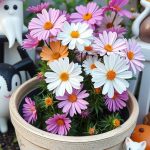Are you curious about flowers that start with the letter “A”? Here’s a comprehensive list of such flowers, including common and easy-to-grow types. Enjoy discovering these beautiful blooms!
If you have a favorite flower that begins with “A,” I’d love to know and explore it with you!
Aster
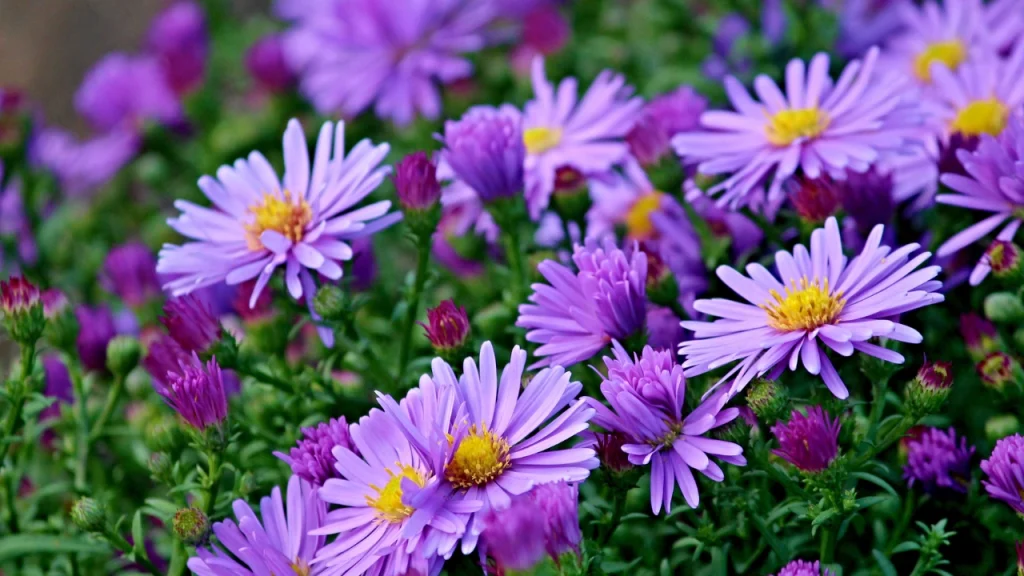
| Common Name | Aster |
|---|---|
| Botanical Name | Aster |
| Family | Asteraceae |
| Plant Type | Perennial |
| Native Range | North America, Europe, Asia |
| Flowering Season | Late summer to fall |
| Mature Size | 1 to 6 feet (30 to 180 cm) tall |
| Sun Exposure | Full sun to partial shade |
| Soil Type | Well-draining, fertile soil |
| Soil pH | Neutral to slightly acidic |
| Bloom Time | Late summer to fall |
| Flower Color | Various shades of purple, pink, blue, white, or yellow |
| Hardiness Zone | 3 to 9 |
| Toxicity | Generally non-toxic |
Aster is a group of plants with 180 species in the Asteraceae family. They used to have over 600 species, but some were moved to different groups after research.
Most of the Aster plants are native to North America, Europe, and Asia, except for one in the Americas. They bloom in late summer and fall, adding pretty colors to the landscape.
Asters are usually three to four feet tall and come in various shades of pink, blue, purple, and white.
Azalea
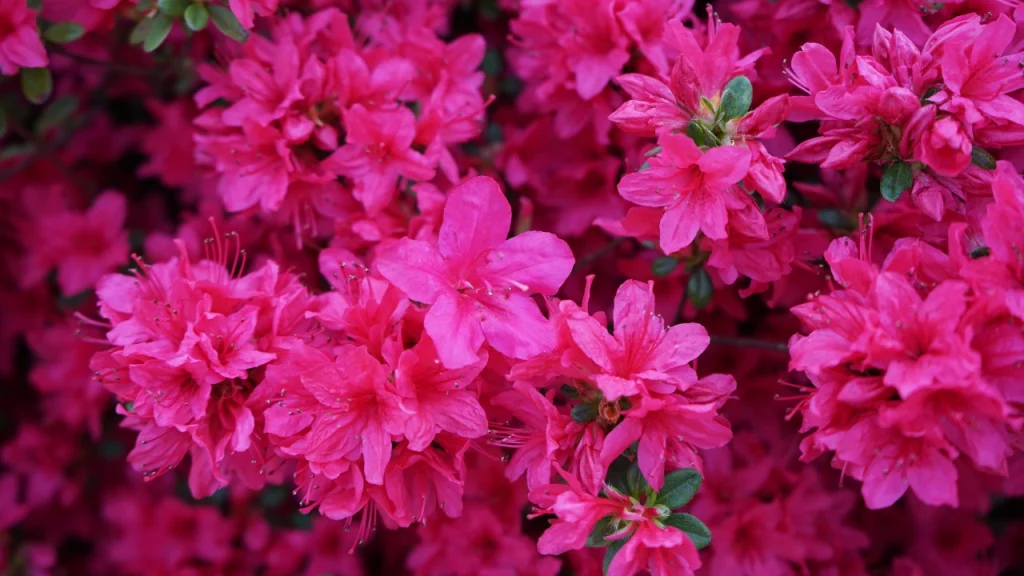
| Common Name | Azalea |
|---|---|
| Botanical Name | Azalea |
| Family | Ericaceae |
| Plant Type | Shrub |
| Native Range | North America, Asia, Europe |
| Flowering Season | Spring, sometimes in fall |
| Mature Size | 2 to 8 feet (60 to 240 cm) tall |
| Sun Exposure | Partial shade to full sun, depending on variety |
| Soil Type | Well-draining, acidic soil |
| Soil pH | Acidic (pH 4.5 to 6) |
| Bloom Time | Spring, sometimes in fall |
| Flower Color | Various shades of pink, white, red, purple, or orange |
| Hardiness Zone | 5 to 9 |
| Toxicity | Mildly toxic if ingested, can cause gastrointestinal discomfort |
Azaleas are flowering shrubs with pretty white, purple, yellow, and red flowers that bloom in spring. They have elliptical leaves and can be evergreen or deciduous.
To grow well, Azaleas need at least four hours of sunlight daily but prefer shade in hot summers. Keep their soil moist, acidic, and fertile.
Plant Azaleas in spring or fall. They grow slowly, and it may take up to 10 years to reach full size. They can be toxic if eaten, so be careful.
Azaleas are lovely plants that add color and charm to gardens, but remember to handle them carefully.
Alstroemeria
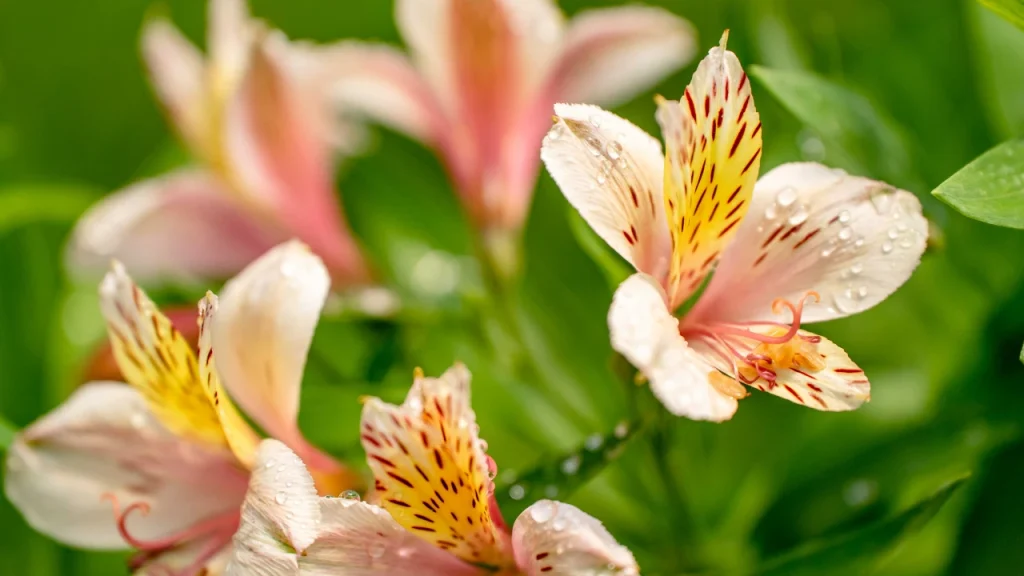
Alstroemeria, also known as Peruvian, parrot, or princess lily, is a beautiful flower belonging to the Alstroemeriaceae family. It originates from South America, with the highest variety found in Chile.
With around 80 species, Alstroemeria offers a wide range of options for home gardeners, thanks to modern hybrids and cultivars.
These lovely flowers are excellent for cutting gardens and come in various colors, forming a rainbow of choices for gardeners. Most Alstroemeria species are perennials and thrive in USDA Plant Hardiness Zones 8 to 10, with some success possible in nearby zones with a little mulch in winter.
With their vibrant hues and year-round growth, Alstroemeria is a delightful addition to any garden.
| Common Name | Alstroemeria |
|---|---|
| Botanical Name | Alstroemeria |
| Family | Alstroemeriaceae |
| Plant Type | Perennial |
| Native Range | South America |
| Flowering Season | Late spring to summer |
| Mature Size | 1 to 3 feet (30 to 90 cm) tall |
| Sun Exposure | Full sun to partial shade |
| Soil Type | Well-draining, fertile soil |
| Soil pH | Neutral to slightly acidic |
| Bloom Time | Late spring to summer |
| Flower Color | Various shades of pink, red, orange, yellow, purple, or white |
| Hardiness Zone | 7 to 10 |
| Toxicity | Generally non-toxic |
Amaryllis
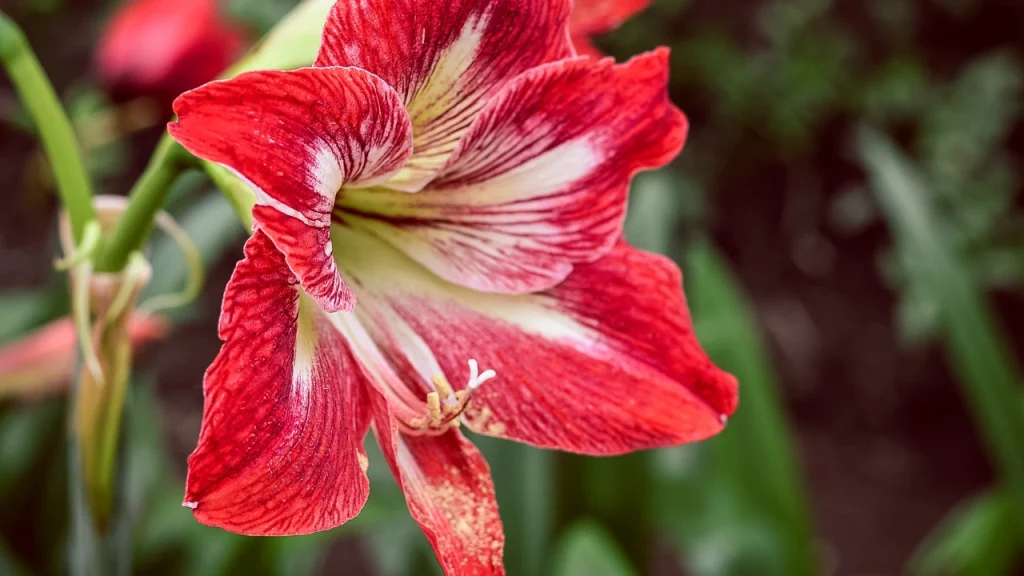
Anemone, also known as a windflower, is a group of plants with delicate flowers that sway in the breeze. They come in various colors like red, orange, yellow, blue, purple, white, and pink.
Anemones are fast-growing plants and can bloom in their first season. They are typically planted in the fall or early spring. Some species can live for a long time, while others have a shorter life.
Be careful as anemones can be toxic if ingested in large amounts. They add beauty to gardens with their pretty flowers that bloom in different seasons.
| Common Name | Amaryllis |
|---|---|
| Botanical Name | Amaryllis |
| Family | Amaryllidaceae |
| Plant Type | Bulbous Perennial |
| Native Range | South America, Caribbean, and Africa |
| Flowering Season | Winter to spring |
| Mature Size | 1 to 2 feet (30 to 60 cm) tall |
| Sun Exposure | Full sun to partial shade |
| Soil Type | Well-draining, fertile soil |
| Soil pH | Neutral to slightly acidic |
| Bloom Time | Winter to spring |
| Flower Color | Various shades of red, pink, orange, white, or striped |
| Hardiness Zone | 9 to 11 |
| Toxicity | Toxic to pets, may cause gastrointestinal discomfort if ingested |
Anemone
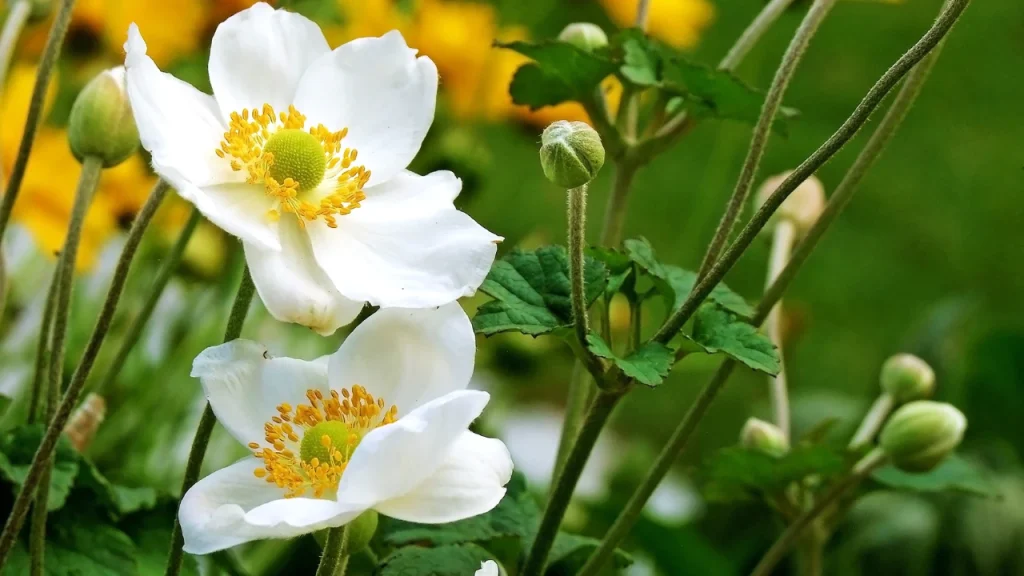
Anemone, also known as windflower, is a group of plants in the Anemone genus. Their delicate poppy-like flowers sway gracefully in the breeze, earning them the name “windflowers” from gardeners. The name “anemone” comes from the Greek word “anemos,” meaning “wind.”
These flowers vary in size and have beautiful colors, ranging from red, orange, and yellow to blue, purple, white, and pink. The flower stems rise from basal leaf clumps and can grow two to five inches in diameter. Some varieties have frilly, double blossoms similar to oversized mums.
Anemones are typically planted in the fall, late winter, or early spring, usually from corms or bare roots. They are fast-growing plants that can bloom in their first season. Depending on the species, their life expectancy can vary from relatively short-lived to lasting for decades.
While anemones add beauty to gardens, it’s essential to be cautious, as they contain a substance called protoanemonin, which makes them moderately toxic to humans if ingested in large quantities and mildly toxic to pets.
Overall, anemones are herbaceous perennials that come in a variety of sizes and colors, bringing vibrant splashes of beauty to gardens during different seasons.
| Common Name | Anemone |
|---|---|
| Botanical Name | Anemone |
| Family | Ranunculaceae |
| Plant Type | Perennial |
| Native Range | Europe, North America, and Asia |
| Flowering Season | Spring to fall |
| Mature Size | Varies by species, generally 1 to 3 feet tall (30 to 90 cm) |
| Sun Exposure | Full sun to partial shade |
| Soil Type | Well-draining, fertile soil |
| Soil pH | Neutral to slightly acidic |
| Bloom Time | Spring to fall |
| Flower Color | Various shades of white, pink, red, purple, or blue |
| Hardiness Zone | Varies by species, typically 4 to 8 |
| Toxicity | Mildly toxic if ingested, may cause skin irritation |
Agapanthus
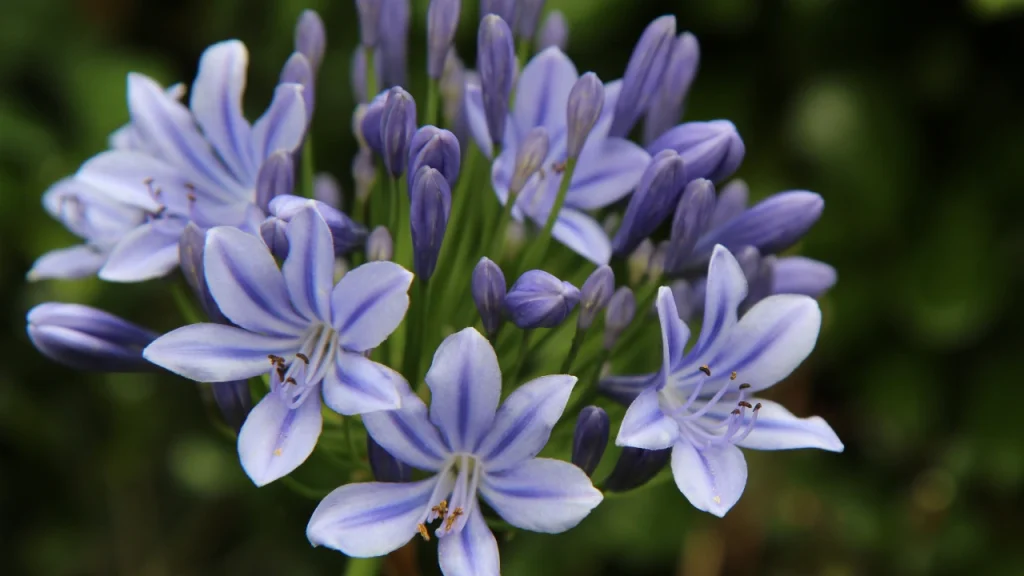
The Agapanthus, also known as the Lily-of-the-Nile or African lily plant, is a beautiful herbaceous perennial from the Amaryllidaceae family.
It is hardy in USDA zones 7 to 11 and hails from South Africa. This stunning plant showcases large clusters of striking blue or white flowers on tall and slender stalks, reaching up to 4 feet (1 m.) in height at maturity.
Its captivating blooms grace the garden from June through August, adding a touch of elegance to any landscape.
| Common Name | Agapanthus |
|---|---|
| Botanical Name | Agapanthus |
| Family | Amaryllidaceae |
| Plant Type | Perennial |
| Native Range | South Africa |
| Flowering Season | Summer |
| Mature Size | 1 to 4 feet (30 to 120 cm) tall |
| Sun Exposure | Full sun to partial shade |
| Soil Type | Well-draining, fertile soil |
| Soil pH | Neutral to slightly acidic |
| Bloom Time | Summer |
| Flower Color | Shades of blue, purple, white, or pink |
| Hardiness Zone | 8 to 11 |
| Toxicity | Mildly toxic if ingested |
Angelonia

Angelonia, also known as Summer Snapdragon, is a lovely flowering plant native to Central and South America. It can be grown as an annual or perennial, depending on the region’s climate. Angelonia displays beautiful spikes of flowers in shades of pink, purple, blue, or white, adding vibrant colors to gardens and landscapes.
This charming plant thrives in full sun and well-draining, fertile soil with a neutral to slightly acidic pH. It blooms from summer to fall, delighting gardeners with its long-lasting flowers. With a mature height of 1 to 2 feet (30 to 60 cm), Angelonia makes a stunning addition to borders, containers, or as bedding plants.
The best part is that Angelonia is non-toxic, making it safe to grow around pets and children. Its ability to attract butterflies and other pollinators adds to its appeal as a delightful and captivating addition to any outdoor space.
| Common Name | Angelonia |
|---|---|
| Botanical Name | Angelonia |
| Family | Plantaginaceae |
| Plant Type | Annual or perennial |
| Native Range | Central and South America |
| Flowering Season | Summer to fall |
| Mature Size | 1 to 2 feet (30 to 60 cm) tall |
| Sun Exposure | Full sun |
| Soil Type | Well-draining, fertile soil |
| Soil pH | Neutral to slightly acidic |
| Bloom Time | Summer to fall |
| Flower Color | Shades of pink, purple, blue, or white |
| Hardiness Zone | Annual: 9 to 11; Perennial: 8 to 11 |
| Toxicity | Non-toxic |
Allium
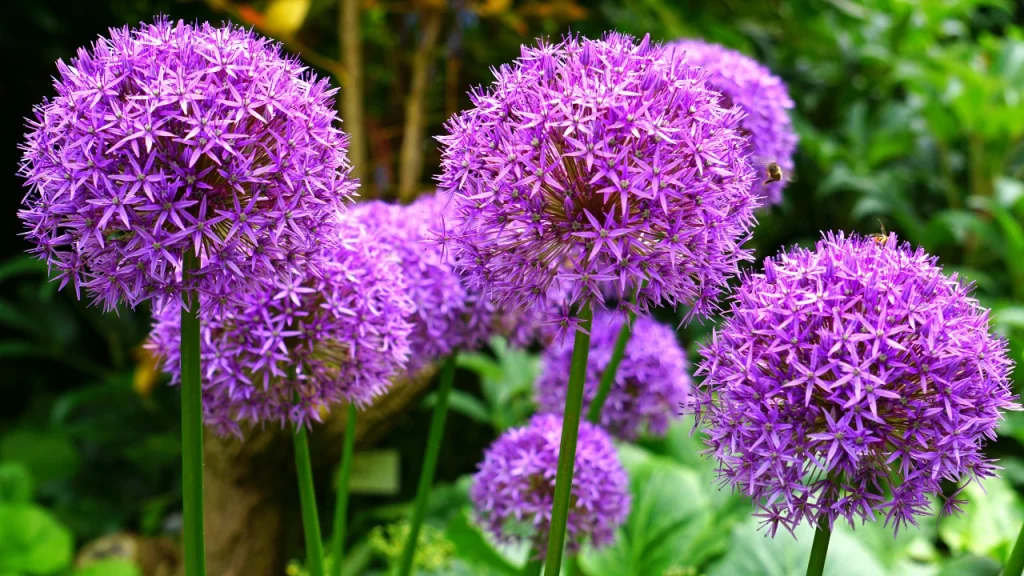
| Common Name | Allium |
|---|---|
| Botanical Name | Allium |
| Family | Amaryllidaceae |
| Plant Type | Perennial |
| Native Range | Various regions in Europe, Asia, and North America |
| Flowering Season | Spring to summer |
| Mature Size | Varies by species, typically 1 to 4 feet (30 to 120 cm) tall |
| Sun Exposure | Full sun |
| Soil Type | Well-draining, fertile soil |
| Soil pH | Neutral to slightly acidic |
| Bloom Time | Spring to summer |
| Flower Color | Various shades of purple, pink, white, yellow, or blue |
| Hardiness Zone | Varies by species, typically 4 to 9 |
| Toxicity | Non-toxic |
Allium, commonly known as ornamental onions, is a group of stunning flowering plants that add a touch of charm to gardens. Native to various regions in Europe, Asia, and North America, these perennial beauties bloom from spring to summer.
With a mature height ranging from 1 to 4 feet (30 to 120 cm), Allium plants display striking globes of flowers in captivating shades of purple, pink, white, yellow, or blue. Their unique and eye-catching flower heads make them a favorite among gardeners.
Allium thrives in full sun and well-draining, fertile soil with a neutral to slightly acidic pH. They are easy to grow and can be an excellent addition to borders, rock gardens, or even containers.
The best part is that Allium is non-toxic, making it a safe choice to grow around pets and children. Its attractive appearance and low-maintenance nature make it a delightful addition to any garden, attracting butterflies and bees with its abundant nectar-rich blooms.
African Daisy

The African Daisy, also known as Arctotis, is a captivating flowering plant native to South Africa. As a perennial, it blooms from spring to fall, displaying a delightful array of colors, including shades of purple, pink, orange, yellow, and white.
Reaching a height of 1 to 2 feet (30 to 60 cm), the African Daisy thrives in full sun and prefers well-draining, sandy-loam soil with a neutral to slightly acidic pH. Its attractive and vibrant flowers make it a popular choice for gardens and landscapes.
With its low-maintenance nature, the African Daisy adds a touch of beauty to outdoor spaces without requiring excessive care. Furthermore, it is non-toxic, making it safe to grow around pets and children.
Whether used in borders, containers, or as ground cover, the African Daisy’s colorful blooms bring cheer and charm to any garden, making it a delightful addition to outdoor settings.
| Common Name | African Daisy |
|---|---|
| Botanical Name | Arctotis spp. |
| Family | Asteraceae |
| Plant Type | Perennial |
| Native Range | South Africa |
| Flowering Season | Spring to fall |
| Mature Size | 1 to 2 feet (30 to 60 cm) tall |
| Sun Exposure | Full sun |
| Soil Type | Well-draining, sandy-loam soil |
| Soil pH | Neutral to slightly acidic |
| Bloom Time | Spring to fall |
| Flower Color | Various shades of purple, pink, orange, yellow, or white |
| Hardiness Zone | 9 to 11 |
| Toxicity | Non-toxic |
Aquilegia
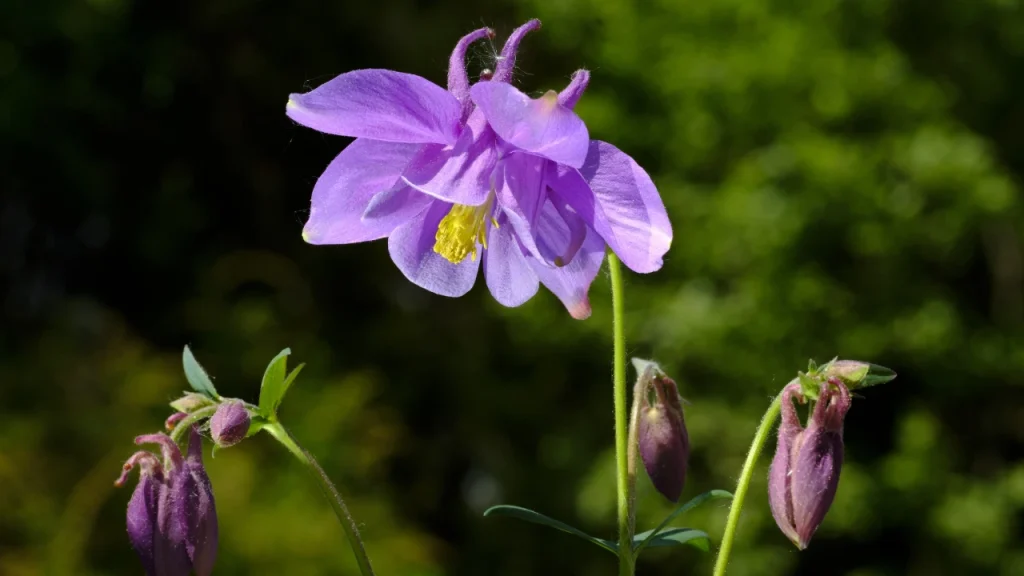
Aquilegia, also known as Columbine, is a delightful perennial flower found in North America and Europe. Its graceful beauty shines during the spring to early summer when it blooms with a variety of enchanting colors, including shades of blue, purple, pink, yellow, and white.
Reaching a height of 1 to 3 feet (30 to 90 cm), Aquilegia thrives in both full sun and partial shade, making it a versatile choice for different garden settings. It prefers well-draining, fertile soil with a neutral to slightly acidic pH.
With its unique and attractive flower shapes resembling elegant bells, Aquilegia adds a touch of elegance to gardens and landscapes. Its nectar-rich blooms are a magnet for pollinators, including bees and butterflies.
While this charming flower adds beauty to outdoor spaces, it’s essential to be cautious, as it is mildly toxic if ingested. Despite this, the Columbine’s enchanting blooms and its ability to attract pollinators make it a popular choice among gardeners looking to create a charming and vibrant garden display.
| Common Name | Aquilegia |
|---|---|
| Botanical Name | Aquilegia |
| Family | Ranunculaceae |
| Plant Type | Perennial |
| Native Range | North America, Europe |
| Flowering Season | Spring to early summer |
| Mature Size | 1 to 3 feet (30 to 90 cm) tall |
| Sun Exposure | Full sun to partial shade |
| Soil Type | Well-draining, fertile soil |
| Soil pH | Neutral to slightly acidic |
| Bloom Time | Spring to early summer |
| Flower Color | Various shades of blue, purple, pink, yellow, or white |
| Hardiness Zone | 3 to 9 |
| Toxicity | Mildly toxic if ingested |
Aubrieta
Aubrieta is a plant with small flowers that stay close to the ground. It’s a type of wildflower found in Europe and Asia.
In spring, it blooms with pretty purple, pink, or white flowers. It grows about 4 to 6 inches tall and spreads 1 to 2 feet wide. Aubrieta likes full sun and well-draining soil.
The flowers come out from late spring to early summer. It’s generally safe for pets, but eating it may upset their stomach.
It’s easy to take care of and adds color to the garden in zones 4 to 8.
| Common Name | Aubrieta |
|---|---|
| Botanical Name | Aubrieta deltoidea, Aubrieta cultorum, Aubrieta x cultorum, and others (species and hybrids) |
| Family | Brassicaceae |
| Plant Type | Perennial |
| Native Range | Europe, Asia |
| Flowering Season | Spring |
| Mature Size | 4 to 6 inches (10 to 15 cm) tall and 1 to 2 feet (30 to 60 cm) wide |
| Sun Exposure | Full sun |
| Soil Type | Well-draining, sandy-loam soil |
| Soil pH | Neutral to slightly alkaline (pH 6.5 to 7.5) |
| Bloom Time | Late spring to early summer |
| Flower Color | Shades of purple, pink, or white |
| Hardiness Zone | 4 to 8 |
| Toxicity | Generally non-toxic, but ingestion may cause mild gastrointestinal upset in pets |
Achillea
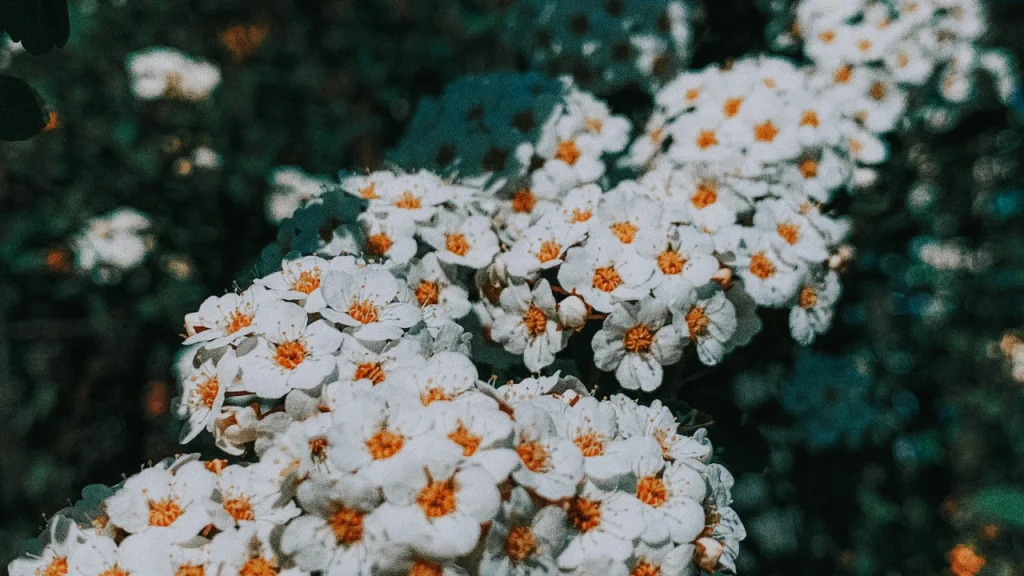
Achillea, commonly known as Yarrow, is a beautiful perennial flower found in North America, Europe, and Asia. This delightful plant blooms from summer to fall, showcasing a range of captivating colors, including shades of pink, red, yellow, white, and orange.
With a mature height of 1 to 3 feet (30 to 90 cm), Achillea thrives in full sun and prefers well-draining, sandy-loam soil with a neutral to slightly alkaline pH (pH 6.5 to 7.5). Its feathery foliage and clusters of charming flowers make it an attractive addition to gardens and landscapes.
Achillea is a hardy plant, capable of withstanding various weather conditions, making it a low-maintenance choice for gardeners. Moreover, it is generally non-toxic, making it safe to grow around pets and children.
With its long-lasting blooms and ability to attract butterflies and other pollinators, Yarrow is a popular choice for creating beautiful and wildlife-friendly garden displays. Its versatility and attractive appearance make it a favorite among garden enthusiasts looking to add natural beauty to their outdoor spaces.
| Common Name | Achillea |
|---|---|
| Botanical Name | Achillea millefolium |
| Family | Asteraceae |
| Plant Type | Perennial |
| Native Range | North America, Europe, and Asia |
| Flowering Season | Summer to fall |
| Mature Size | 1 to 3 feet (30 to 90 cm) tall |
| Sun Exposure | Full sun |
| Soil Type | Well-draining, sandy-loam soil |
| Soil pH | Neutral to slightly alkaline (pH 6.5 to 7.5) |
| Bloom Time | Summer to fall |
| Flower Color | Various shades of pink, red, yellow, white, or orange |
| Hardiness Zone | 3 to 8 |
| Toxicity | Generally non-toxic |
Amaranthus
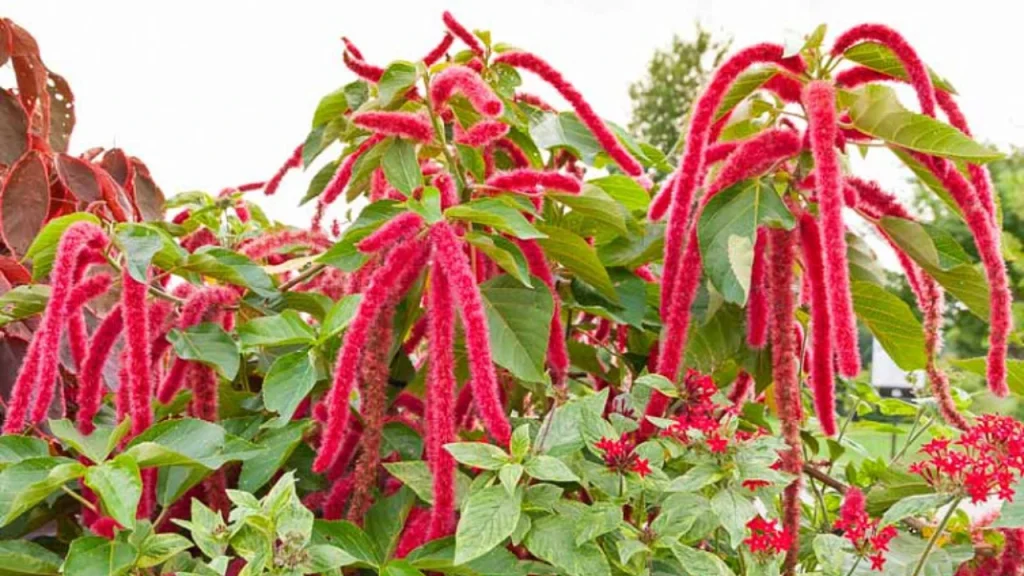
Amaranthus, commonly known as Amaranth, is a captivating annual flower found in the Americas, Africa, and Asia. It blooms from summer to fall, boasting an impressive array of colors, including shades of red, orange, yellow, green, and purple.
With a mature height ranging from 1 to 6 feet (30 to 180 cm), Amaranthus thrives in full sun and prefers well-draining, fertile soil with a neutral to slightly acidic pH. Its vibrant and eye-catching flower heads make it a favorite among gardeners.
Amaranth is a versatile flower that can add beauty to various garden settings, whether used in borders, containers, or as bedding plants. Its long-lasting blooms and striking foliage make it a popular choice for creating attractive garden displays.
Moreover, Amaranthus is generally non-toxic, making it safe to grow around pets and children. With its colorful and ornamental features, this annual flower is an excellent addition to any garden, adding a touch of beauty and vibrancy to outdoor spaces.
| Common Name | Amaranthus |
|---|---|
| Botanical Name | Amaranthus |
| Family | Amaranthaceae |
| Plant Type | Annual |
| Native Range | Americas, Africa, Asia |
| Flowering Season | Summer to fall |
| Mature Size | Varies by species, typically 1 to 6 feet (30 to 180 cm) tall |
| Sun Exposure | Full sun |
| Soil Type | Well-draining, fertile soil |
| Soil pH | Neutral to slightly acidic |
| Bloom Time | Summer to fall |
| Flower Color | Various shades of red, orange, yellow, green, or purple |
| Hardiness Zone | Varies by species, typically 2 to 11 (USDA zones) |
| Toxicity | Generally non-toxic |
Antirrhinum
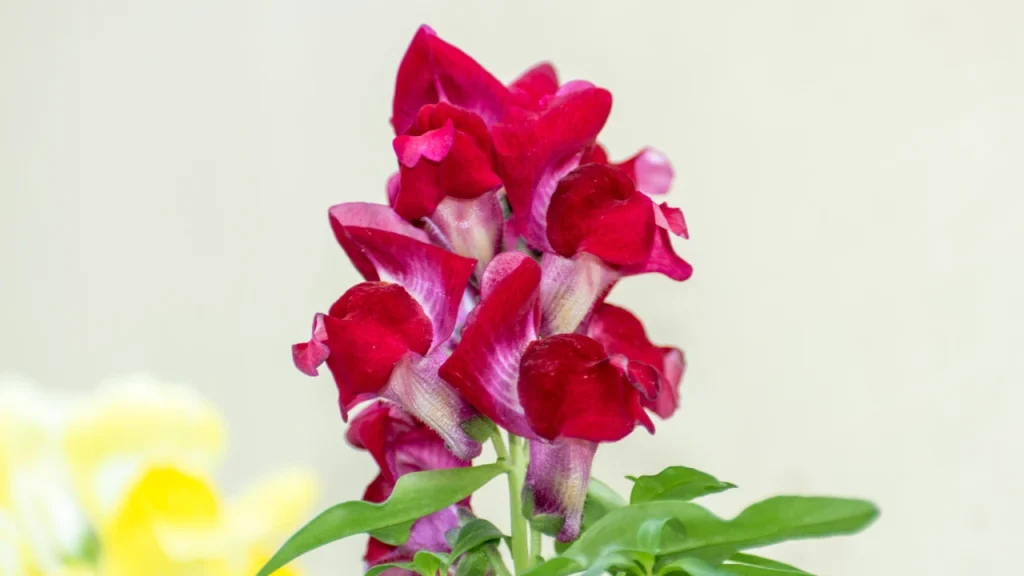
Antirrhinum, commonly known as Snapdragon, is a charming flower found in Europe, North America, and Africa. It blooms from spring to fall, gracing gardens with a delightful range of colors, including shades of pink, red, orange, yellow, white, and purple.
With a mature height varying from 1 to 3 feet (30 to 90 cm), Antirrhinum thrives in full sun and prefers well-draining, fertile soil with a neutral to slightly acidic pH. Its unique and captivating flower shape resembles a dragon’s mouth, giving it the name “Snapdragon.”
Snapdragons can be grown as annuals or perennials, depending on the region’s climate. They are a favorite among gardeners for their bright and showy blooms, making them an excellent choice for adding color and vibrancy to gardens and landscapes.
Moreover, Antirrhinum is generally non-toxic, making it safe to grow around pets and children. Its appealing appearance and wide range of colors make it a popular and delightful addition to any garden, attracting butterflies and other pollinators with its nectar-rich flowers.
| Common Name | Antirrhinum |
|---|---|
| Botanical Name | Antirrhinum spp. |
| Family | Plantaginaceae |
| Plant Type | Annual or perennial |
| Native Range | Europe, North America, and Africa |
| Flowering Season | Spring to fall |
| Mature Size | Varies by species, typically 1 to 3 feet (30 to 90 cm) tall |
| Sun Exposure | Full sun |
| Soil Type | Well-draining, fertile soil |
| Soil pH | Neutral to slightly acidic |
| Bloom Time | Spring to fall |
| Flower Color | Various shades of pink, red, orange, yellow, white, or purple |
| Hardiness Zone | Varies by species, typically 4 to 10 (USDA zones) |
| Toxicity | Generally non-toxic |
Ageratum
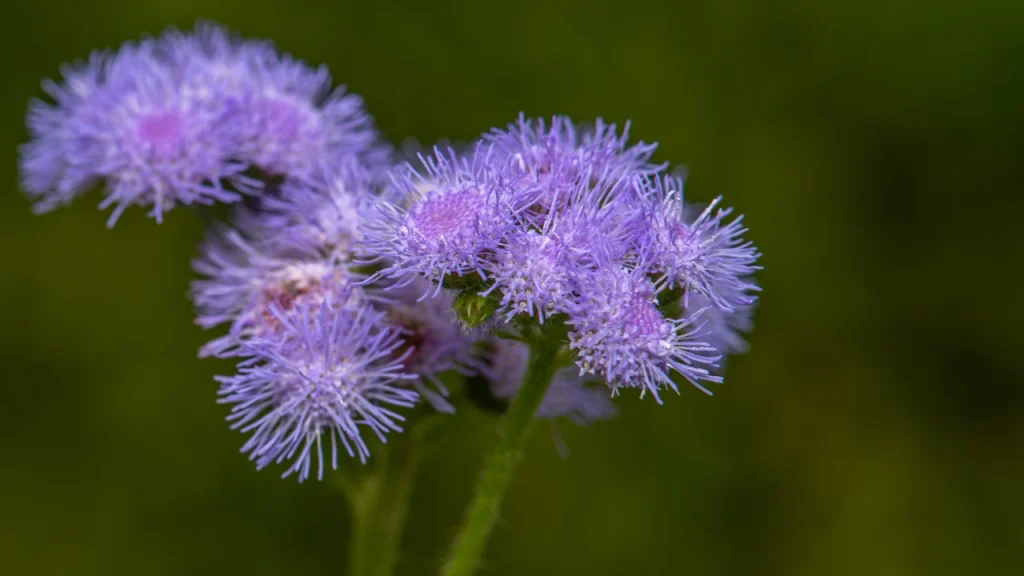
Ageratum, also known as Flossflower, is a lovely annual flower originating from Central America. It blooms from summer to fall, displaying delicate and fluffy flowers in charming shades of blue, pink, or white.
With a mature height ranging from 6 inches to 2 feet (15 to 60 cm), Ageratum thrives in both full sun and partial shade. It prefers well-draining, fertile soil with a neutral to slightly acidic pH.
The Ageratum’s soft and fluffy blooms make it a popular choice for adding a touch of elegance and color to gardens and landscapes. Its low-growing habit makes it suitable for borders, containers, and as bedding plants.
Moreover, Ageratum is non-toxic, making it safe to grow around pets and children. Its dainty appearance and attractive colors make it a delightful addition to any garden, attracting butterflies and other pollinators with its nectar-rich flowers.
| Common Name | Ageratum |
|---|---|
| Botanical Name | Ageratum houstonianum |
| Family | Asteraceae |
| Plant Type | Annual |
| Native Range | Central America |
| Flowering Season | Summer to fall |
| Mature Size | 6 inches to 2 feet (15 to 60 cm) tall |
| Sun Exposure | Full sun to partial shade |
| Soil Type | Well-draining, fertile soil |
| Soil pH | Neutral to slightly acidic |
| Bloom Time | Summer to fall |
| Flower Color | Shades of blue, pink, or white |
| Hardiness Zone | 9 to 11 |
| Toxicity | Non-toxic |
Alyssum
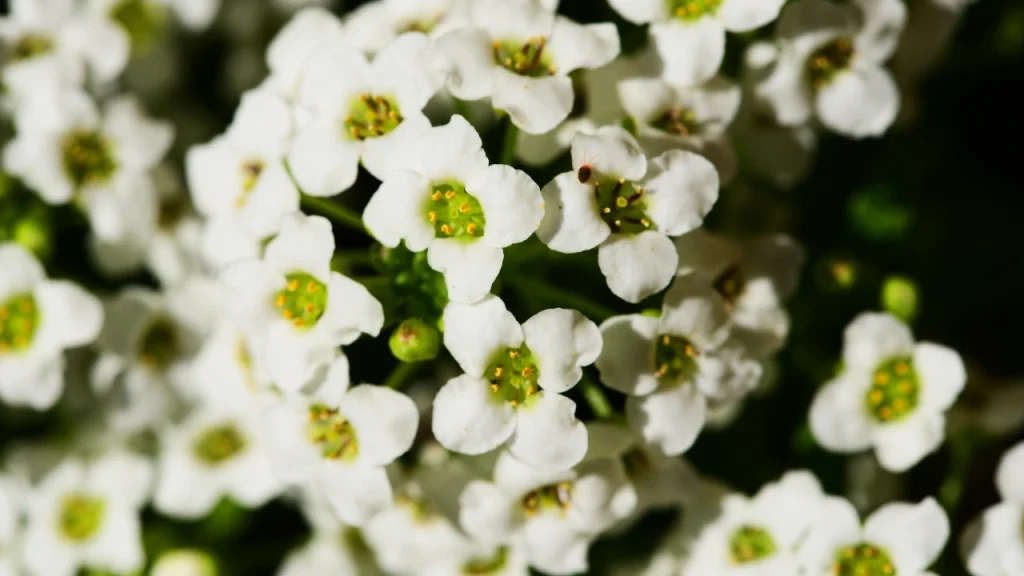
Sweet Alyssum, also known as a colorful carpet of tiny flowers, comes in various shades, including white, pink, purple, or lavender. It is a quick-growing plant native to Europe, covering the ground with its delicate cross-shaped, four-petal blooms and gray-green, slightly hairy leaves.
This cool-season flower is easy to grow from seeds or plants and can be planted in early spring after the last frost. In frost-free regions, it thrives throughout fall and winter, blooming again after the summer heat fades.
While it adds beauty to gardens, it’s essential to note that Sweet Alyssum can be invasive in California and grow aggressively in other parts of the United States.
| Common Name | Alyssum |
|---|---|
| Botanical Name | Lobularia maritima |
| Family | Brassicaceae |
| Plant Type | Annual or perennial |
| Native Range | Mediterranean region |
| Flowering Season | Spring to fall |
| Mature Size | 4 to 8 inches (10 to 20 cm) tall |
| Sun Exposure | Full sun |
| Soil Type | Well-draining, sandy-loam soil |
| Soil pH | Neutral to slightly alkaline (pH 6.0 to 7.5) |
| Bloom Time | Spring to fall |
| Flower Color | White, pink, purple, or lavender |
| Hardiness Zone | 3 to 9 |
| Toxicity | Non-toxic |
Abutilon
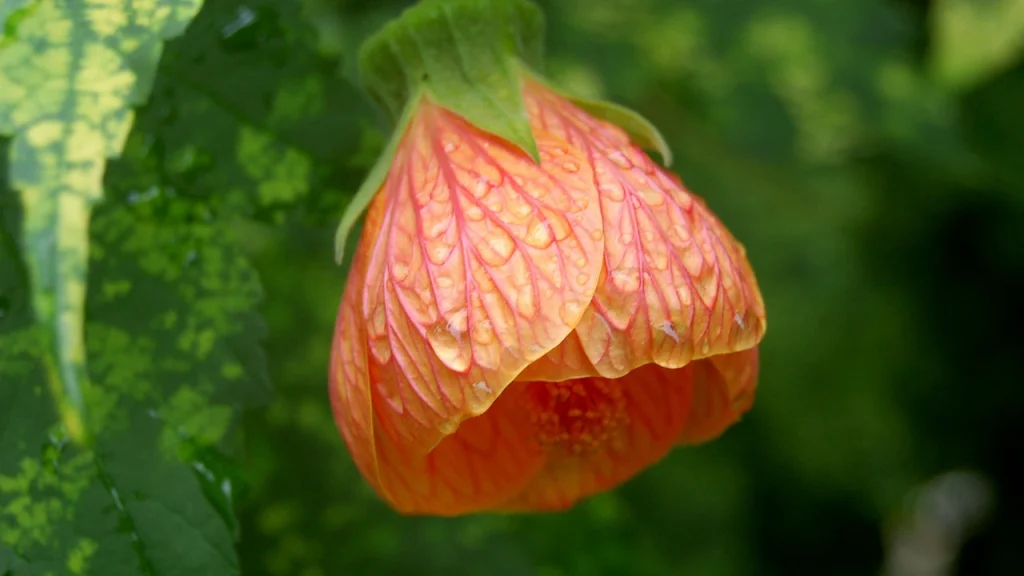
Abutilon, commonly known as Flowering Maple or Chinese Lantern, is a captivating perennial or shrub found in tropical and subtropical regions. It brings a burst of color to gardens and landscapes with its stunning bell-shaped flowers in shades of red, orange, yellow, pink, or white.
Thriving in both full sun and partial shade, Abutilon prefers well-draining, fertile soil with a neutral to slightly acidic pH. It’s attractive foliage and vibrant blooms make it a popular choice among gardeners looking to add beauty and charm to their outdoor spaces.
One of the best features of Abutilon is its versatility, as it can be grown as either a perennial or a shrub. Its non-toxic nature ensures that it’s safe to grow around pets and children, making it a delightful addition to any garden. With its long flowering season from spring to fall, Abutilon creates a colorful and enchanting display that is sure to impress all who see it.
| Common Name | Abutilon |
|---|---|
| Botanical Name | Abutilon |
| Family | Malvaceae |
| Plant Type | Perennial or shrub |
| Native Range | Tropical and subtropical regions |
| Flowering Season | Spring to fall |
| Mature Size | Varies by species, typically 3 to 10 feet (1 to 3 meters) tall |
| Sun Exposure | Full sun to partial shade |
| Soil Type | Well-draining, fertile soil |
| Soil pH | Neutral to slightly acidic |
| Bloom Time | Spring to fall |
| Flower Color | Various shades of red, orange, yellow, pink, or white |
| Hardiness Zone | Varies by species, typically 8 to 11 (USDA zones) |
| Toxicity | Non-toxic |
Armeria
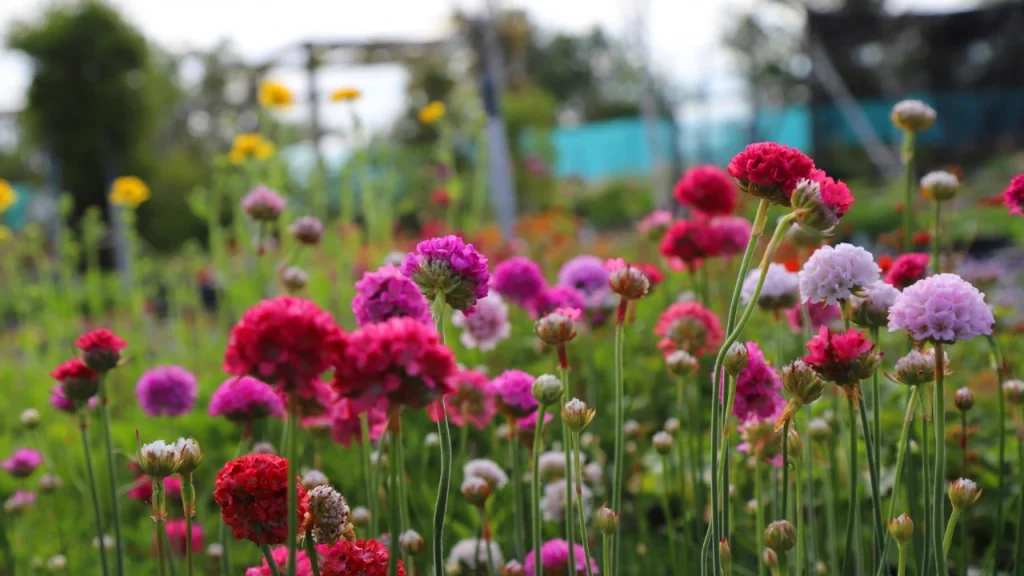
Armeria, also called Sea Thrift, is a pretty flower found in Europe, Asia, and North America. It blooms from spring to summer in shades of pink, white, or purple.
It grows to about 6 inches to 1 foot tall and likes sunny or partly shaded areas with well-draining soil. Its cute flowers and grass-like leaves make it a favorite in gardens.
Armeria is safe for pets and children, and it can survive in different conditions. It adds a touch of coastal charm and beauty to gardens all through spring and summer.
| Common Name | Armeria |
|---|---|
| Botanical Name | Armeria |
| Family | Plumbaginaceae |
| Plant Type | Perennial |
| Native Range | Europe, Asia, and North America |
| Flowering Season | Spring to summer |
| Mature Size | 6 inches to 1 foot (15 to 30 cm) tall |
| Sun Exposure | Full sun to partial shade |
| Soil Type | Well-draining, sandy or loamy soil |
| Soil pH | Neutral to slightly alkaline (pH 6.0 to 7.5) |
| Bloom Time | Spring to summer |
| Flower Color | Various shades of pink, white, or purple |
| Hardiness Zone | 3 to 8 |
| Toxicity | Non-toxic |
Anthemis
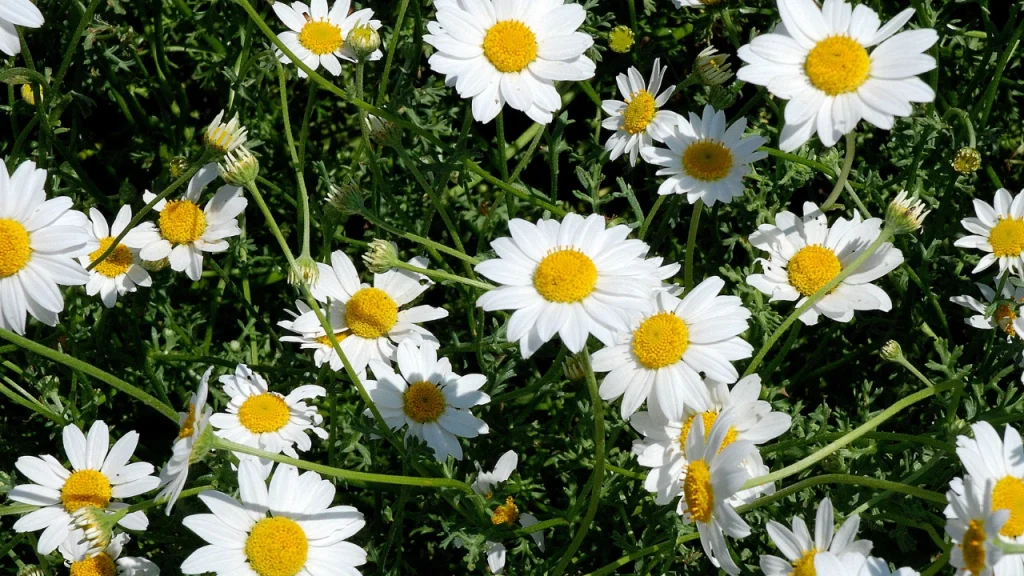
Anthemis, also known as Chamomile or Mayweed, is a charming perennial flower native to Europe, Asia, and North Africa. Its delicate blooms grace gardens from late spring to summer, showcasing various shades of white, yellow, or pink.
With a mature height ranging from 1 to 3 feet (30 to 90 cm), Anthemis thrives in full sun and prefers well-draining, fertile soil with a neutral to slightly alkaline pH (pH 6.0 to 7.5).
Anthemis’ lovely flowers and attractive foliage make it a popular choice for adding beauty and natural appeal to gardens. Its calming fragrance and association with chamomile tea add to its allure.
Moreover, Anthemis is non-toxic and safe to grow around pets and children. Its resilience and ability to attract beneficial insects make it a delightful addition to any garden, providing a lovely display of colors and scents throughout late spring and summer.
| Common Name | Anthemis |
|---|---|
| Botanical Name | Anthemis |
| Family | Asteraceae |
| Plant Type | Perennial |
| Native Range | Europe, Asia, and North Africa |
| Flowering Season | Late spring to summer |
| Mature Size | Varies by species, typically 1 to 3 feet (30 to 90 cm) tall |
| Sun Exposure | Full sun |
| Soil Type | Well-draining, fertile soil |
| Soil pH | Neutral to slightly alkaline (pH 6.0 to 7.5) |
| Bloom Time | Late spring to summer |
| Flower Color | Various shades of white, yellow, or pink |
| Hardiness Zone | 3 to 9 |
| Toxicity | Non-toxic |
Agave
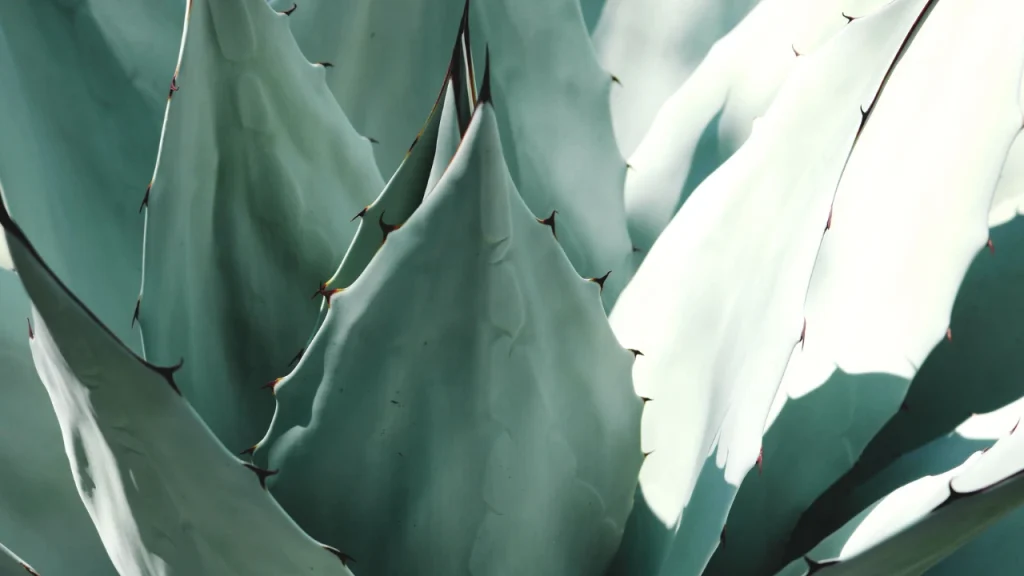
Agave is a fascinating succulent plant known for its unique and striking appearance. It is native to the Americas, primarily found in Mexico. Agave plants vary in size, with some growing as tall as 1 to 10 feet (30 cm to 3 meters).
With its sharp and spiky leaves arranged in rosettes, Agave is well-adapted to arid and sunny environments. It thrives in full sun and prefers well-draining soil with a neutral to slightly acidic pH.
Agave’s flowering season and flower color vary depending on the species. Some species produce tall flower spikes with attractive blooms, while others have more inconspicuous flowers.
While Agave adds a touch of natural beauty to gardens and landscapes, it’s crucial to note that some species can be toxic to humans and pets. As such, it’s essential to check the specific species before planting and ensure safe cultivation.
Due to their striking appearance and adaptability, Agave plants are a popular choice for xeriscaping and adding a touch of desert charm to gardens.
| Common Name | Agave |
|---|---|
| Botanical Name | Agave |
| Family | Asparagaceae |
| Plant Type | Succulent |
| Native Range | Americas, primarily Mexico |
| Flowering Season | Varies by species |
| Mature Size | Varies by species, typically 1 to 10 feet (30 cm to 3 meters) tall |
| Sun Exposure | Full sun |
| Soil Type | Well-draining soil |
| Soil pH | Neutral to slightly acidic |
| Bloom Time | Varies by species |
| Flower Color | Varies by species |
| Hardiness Zone | Varies by species, typically 8 to 11 (USDA zones) |
| Toxicity | Some species are toxic to humans and pets, check specific species |
Aconitum
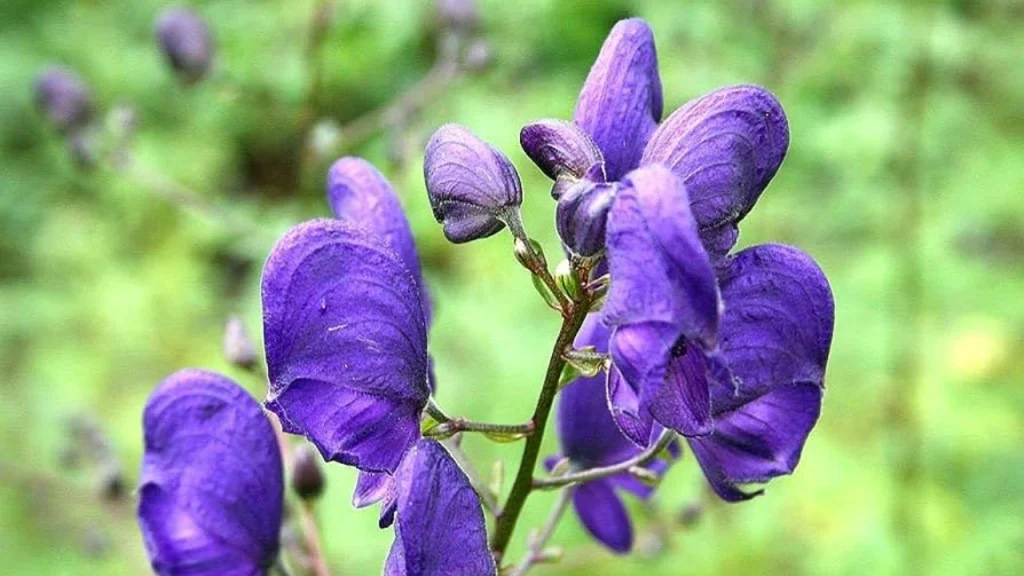
| Common Name | Aconite, Monkshood, Wolfsbane |
|---|---|
| Botanical Name | Aconitum |
| Family | Ranunculaceae |
| Plant Type | Perennial |
| Native Range | Temperate regions of Asia, Europe, and North America |
| Flowering Season | Summer to early autumn |
| Mature Size | Varies by species, typically 2 to 6 feet (60 to 180 cm) tall |
| Sun Exposure | Partial shade to full sun |
| Soil Type | Moist, well-draining soil |
| Soil pH | Neutral to slightly acidic |
| Bloom Time | Summer to early autumn |
| Flower Color | Various shades of blue, purple, or white |
| Hardiness Zone | Varies by species, typically 3 to 7 (USDA zones) |
| Toxicity | Highly toxic due to Aconitine alkaloids |
Aconitum, commonly known as Aconite, Monkshood, or Wolfsbane, is a group of perennial plants with distinctive and striking blooms. Native to temperate regions of Asia, Europe, and North America, these flowers add a touch of enchantment to gardens and landscapes.
Aconitum plants typically grow 2 to 6 feet (60 to 180 cm) tall and produce stunning flowers in shades of blue, purple, or white. They bloom from summer to early autumn, gracing the surroundings with their alluring colors.
While Aconitum flowers are beautiful, it’s crucial to handle them with care as they are highly toxic due to the presence of Aconitine alkaloids. Caution should be taken while planting or working with these plants to ensure safety.
Due to their unique appearance and historical associations with folklore and medicine, Aconitum plants have captured the fascination of many gardeners and plant enthusiasts. However, it’s important to remember their toxicity and exercise caution when dealing with these captivating flowers.
Bottom Line
Hope you like my flower list. If you have any favorite flower that starts with “A” l will include you in my list.
Related Posts:



